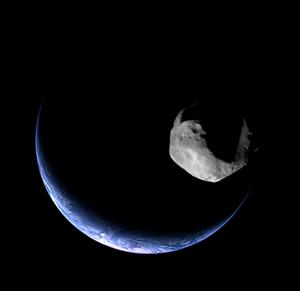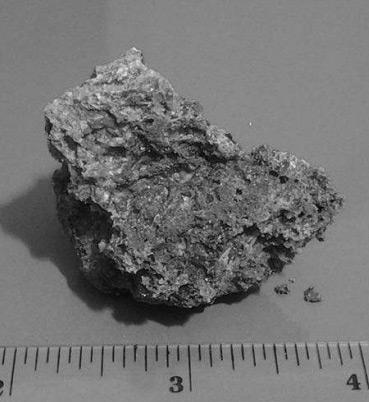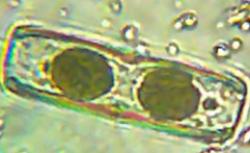Oh boy. Here we go again, again.
In January, I wrote about Chandra Wickramasinghe, who claimed he had found fossilized diatoms (microscopic plant life) in a meteorite. I showed pretty carefully why this claim is very wrong, but apparently it wasn’t enough: A new paper from Wickramasinghe’s team has been published furthering the claims, and it’s getting picked up by mainstream media.
I read the paper, and really it’s more of the same as from the first paper. In some ways, it’s even shakier; they provide lots of technical data that gives their work a veneer of credibility, but when you look a bit deeper you find they didn’t do a lot of critically necessary tests to establish the veracity of their claims. All the technical stuff obfuscates the fact that they missed the boat in some very basic ways.
In a nutshell, they don’t establish the samples they examined were actually meteorites. They don’t establish they were from the claimed meteor event over Sri Lanka in December 2012. And perhaps most telling, they don’t eliminate the possibility of contamination; that is, diatoms got into the samples because those rocks were sitting on the Earth where diatoms are everywhere.
There’s more, too, including some unusual methods if you’re trying to establish a paradigm-overthrowing claim: They don’t consult with outside experts (including those in the fields of meteorites and diatoms), they don’t get independent confirmation from an outside lab, and they published in a journal that is, um, somewhat outside the mainstream of science.
You want details? I got details.
Great balls of fire!
In the paper, they first try to establish that the rock sample they have is from a fireball—a very bright meteor—over the province of Polonnaruwa, Sri Lanka that occurred in the early evening of December 29, 2012. The fireball was witnessed by a large number of people, and there are claims of people getting burned, smelling noxious fumes, and so on.

Image credits: Earth: ESA/Rosetta; asteroid Mathilde: NASA/NEAR
I tend to be highly skeptical of claims involving burns and such, since most meteorites are cold upon impact. They spend a lot of time in deep space (where it’s cold) and are only heated briefly (like, for a few seconds at most) as they plow through the atmosphere. Also, the reports of fumes, if true, may have been more from local contamination. That happened in Peru recently after a largish meteorite impacted there, releasing arsenic-tainted ground water.
All that aside, people then collected black rocks they found in the area. However, there is no real way to establish that the rocks picked up were from this particular fireball. A meteorite was found in the same area back in 2004, for example. It’s entirely possible that any samples examined were from older falls, and not from the 2012 fireball. Wickramasinghe’s team does nothing at all to tie the samples in to that fireball. They just assume the connection, without any proof.
Meteorwrong
But there’s more: They still haven’t established this rock is even a meteorite at all! They make this claim many times in the paper, but they do so without firm proof. They examined the rock using various methods, but none of them establish the sample as being a meteorite. Quite the opposite, in fact.
One method was an oxygen isotope analysis. Basically, there are different isotopes of stable oxygen—ones with eight, nine, or ten neutrons in the atomic nucleus. In general, the ratios of these isotopes will be different from rocks that have origins in different parts of the solar system. If you collect a bunch of Earth rocks and get the ratio, and compare it to the ratios from rocks from, say, Mars, you’ll get different ratios. This allows you in principle to say that a given rock must not have formed on Earth.
Wickramasinghe’s team did this analysis, and found the ratios from their sample differ from the Earth standard. They then claim, “We conclude that the oxygen isotope data show [our samples] are unequivocally meteorites”.
But wait! Is that true? [Spoiler: no.]

Image credit: Wickramasinghe, et al.
To find out, I talked to planetary scientist Barbara Cohen, who studies meteorites at NASA’s Marshall Space Flight Center. She told me the data in the paper is “suggestive”, but not conclusive at all. At best it should be followed up with other tests, because it’s not hard at all to throw that test off.
For example, carbonates are molecules that are oxygen-rich and can form quite quickly on a meteorite sitting on the ground. Carbonates will change the oxygen isotope ratio, and can make an ordinary rock look extraterrestrial. Dr. Cohen told me there are ways of compensating for it, like washing the samples in a solution of acetic or hydrochloric acid; that dissolves the carbonates away. This is a very standard procedure meteorite scientists do before examining the chemical composition of suspected meteorites.
In the paper by Wickramasinghe’s team, they give a detailed description of how they prepped the samples, and nowhere do they mention this procedure to minimize carbonate contamination.
Perhaps they forgot to mention it. But even if they had, the non-standard oxygen isotope ratio is not proof of extraterrestriality, it just isn’t necessarily inconsistent with it. So really, their claim that the isotope ratio proves “unequivocally” these are meteorites is wrong, plain and simple.
There are other simple procedures that should be done to establish authenticity, but none is mentioned in the paper. For example, they should be examining the “mineral assemblages”, the groupings of minerals in the rock. This can help establish the geologic history of the sample, which is pretty standard for meteorite analysis. But they didn’t do this or really very much else to establish an off-world origin for their samples.
And finally, they say that the samples are 85-95 percent amorphous (non-crystalline) silica. However, as Cohen pointed out to me, no meteorite known has that much silica in it, let alone one of the kind they claim (a carbonaceous chondrite). That by itself is enough to show their rock is almost certainly not a meteorite. As Cohen told me, “You need to start off establishing this is a meteorite, but they have not done that.”
And again, let me point out that they didn’t go to an outside lab to substantiate their results. Not their conclusions, just their data. It’s no hardship to chisel off a piece of a rock and send it to a lab for analysis; they did it for themselves, so why not get someone else to do it as well?
Nor did they do this for their diatom samples. It’s odd that they’re making claims about diatoms in a meteorite, but didn’t go to any outside experts in either diatoms or meteorites. I’d want to do that even if my claims were rather mundane. But given the magnitude of what they’re saying?
Decontamination
I mentioned that their analysis doesn’t seem to include any efforts at decontamination. That’s true for carbonate contamination, but it’s also true for biological contamination. If you’re claiming you found diatoms in a meteorite, you’d better have incredibly tight constraints on contamination. Yet they produce none. In fact, in the very first paragraph of their paper they say some samples were found in a rice field! Not to put too fine a point on it, these are known to be rather wet areas, with lots of little critters swimming in the water. There was little or no control at all on how these samples were obtained.
Also, Wickramasinghe’s team claims they found diatoms deep inside the samples, and therefore can’t be contaminated. But this is incorrect. I’ve talked to biologists who look for life in rocks, and they say that contamination is a huge problem. These buggers are small and can find their ways into the smallest cracks and fissures. I’ll note the samples Wickramasinghe’s team examined are riddled with vesicles, tiny bubbles in the rock. That is a pretty convenient pathway for life to wiggle through.
Bass Ackwards

Image credit: Wickramasinghe, et al.
So, they find some rocks, they claim (without enough evidence) that they’re meteorites, and they claim (without evidence) they’re from a recent meteorite fall. They find diatoms, and they claim (without controlling for contamination) that not only these diatoms came from space, but that meteorites like this seeded Earth with life.
Which is more likely: that, or that they found a rock from Earth that already had diatoms in it? Just like essentially any porous rock you find in a wet area?
Mind you, at the end of a previous paper, they claimed they found living diatoms deep inside the meteorite. Living, as in alive. When we know there are already quadrillions of such beasties everywhere on planet Earth.
Their claims are, down to a one, extraordinary, with pretty underwhelming evidence to support them. So the idea that these are ordinary rocks found in wet conditions under no control that have been sitting around a long time and are therefore loaded with diatoms that evolved here on good ol’ planet Earth seems just a tad more likely to me.
In my opinion, Wickramasinghe and his team are not just wrong, they are precisely wrong: Life didn’t crawl from this rock onto the Earth, life crawled into this rock from the Earth.

Image credit: Wickramasinghe, et al.
I’m not saying aliens, but aliens.
So it’s pretty clear that at best, given the evidence they themselves present, even stating these samples are meteorites at all is shaky, and it doesn’t get any better from there.
And once again, I feel obligated to point out that Wickramasinghe has a history of making extraordinary claims based on evidence that doesn’t support them…and then publishing these claims in a journal (the “Journal of Cosmology”) which has a less-than-stellar reputation. I give plenty of details about that in the previous article I wrote about this claim. And I’ll note as I did in the previous post that this is not really an argumentum ad hominem, but more of a meta-argument made on past behavior; if someone has a long record of making nonsubstantiated claims, you really do need to keep that in mind when examining the latest one. It doesn’t mean the claim is wrong, but it does mean you should be extra wary.
Extraordinary claims demand extraordinary evidence. Here we have one, but we most certainly do not have the other.